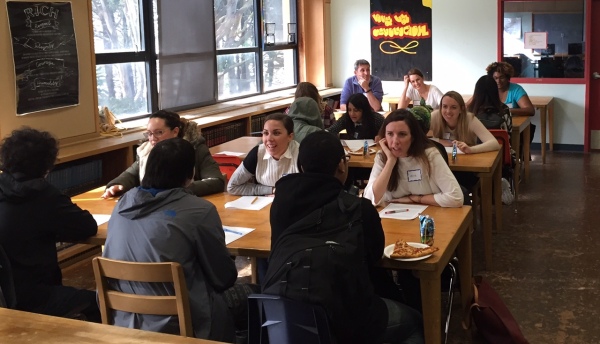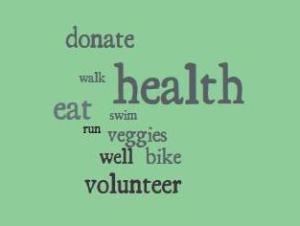
AdRoll employees meet with June Jordan sophomore students.
By their sophomore year, high school students are expected to start seriously thinking about life after graduation. While they’re still figuring out high school, navigating relationships and just being teenagers, deciding a life path can put a lot of pressure on a student, especially for those who come from a low-income household and might not receive extra support at home.
Enter the volunteer component of our College & Career Readiness program, in which San Francisco professionals are trained to coach high school students as they face tough decisions and exciting opportunities. After launching the program at Mission High School last semester, this month the San Francisco Education Fund brought the program to June Jordan School for Equity.
Employees from AdRoll will serve as volunteer coaches for students, expanding on the relationship the company has steadily built with June Jordan since 2014. As a Circle the Schools partner, AdRoll has hosted multiple events for June Jordan students, including a tour of their office last year where they met CEO Aaron Bell. The company also placed several students, including June Jordan juniors and seniors, in AdRoll internships.
On Friday, 10th grade students met with 21 employees from AdRoll in rapid succession as part of a speed matching event to determine who would be their coaches. Over pizza and Capri Sun, students talked with their prospective coaches about their goals and dreams.
Estuardo, a 10th-grader at June Jordan, sees the program as a chance to figure out all the colleges he should explore. While he already knows he’s interested in engineering, he admits he hasn’t yet fully considered which schools he should look at.
“I think it’s really cool,” he said. “It’s an opportunity to really engage and figure out what kind of college you want to go to and get advice.”
AdRoll employee Job understands firsthand just how difficult high school can be. Though he’s a successful advertising professional now, his future wasn’t always so clear.
“I got into a lot of trouble as a high school student,” he said. “I was hard to [reach]. I want to help someone like me and help them avoid some of the mistakes I made.”
Job is already familiar with the school after having volunteered for a June Jordan-AdRoll breakfast event and helping out during the office visit, but he looks forward to getting involved in a one-on-one capacity with a student. He said he’s excited to make “a real difference in someone’s life” and help a high school student work through difficult problems and choices.
While AdRoll employee Rebecca said the plan for her to attend college and then graduate school was drilled in from an early age, she knows many students don’t see higher education this way.
“I know not everyone thinks about it until it is too late,” she said. Rebecca said she wants to use her experience to help students figure out what college is really like and help them explore schools they might not know are out there.
As for what might make AdRoll employees nervous about the experience? On the ride over from AdRoll to June Jordan, Rebecca said it occurred to her and her colleagues that they might not know the lingo teens use today or what kind of music they listen to. She hopes she can relate to her student.
“We might not be cool anymore,” Rebecca said with a laugh.
Students will work with volunteers one-on-one for about an hour each week from sophomore year until graduation as they chart their college and career path. Stay tuned as we pair June Jordan students with their AdRoll coaches and follow their progress!
In addition to placing volunteers in classrooms, our College & Career Program also includes innovation grants for teachers. Learn more about the program.
Does your company want to adopt a school like June Jordan? Learn more about our Circle the Schools program, a partner program with sf.citi and SFUSD.

